Fungicide impacts on photosynthesis in crop plants( 2012)
- 格式:pdf
- 大小:590.56 KB
- 文档页数:12
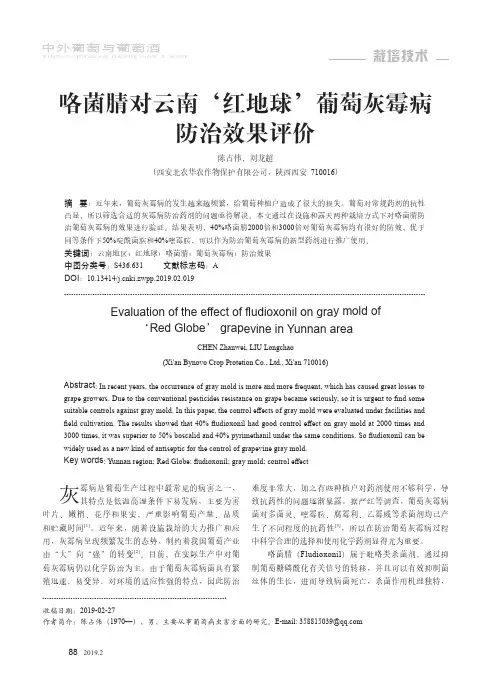
S I N O -O V E R S E A S G R A P E V I N E & W I N E栽培技术中外葡萄与葡萄酒882019.2咯菌腈对云南‘红地球’葡萄灰霉病防治效果评价陈占伟,刘龙超(西安北农华农作物保护有限公司,陕西西安 710016)Evaluation of the effect of fludioxonil on gra y mold of‘Red Globe ’ grap evine in Yunnan areaCHEN Zhanwei, LIU Longchao(Xi'an Bynovo Crop Protetion Co., Ltd., Xi'an 710016)摘 要:近年来,葡萄灰霉病的发生越来越频繁,给葡萄种植户造成了很大的损失。
葡萄对常规药剂的抗性凸显,所以筛选合适的灰霉病防治药剂的问题亟待解决。
本文通过在设施和露天两种栽培方式下对咯菌腈防治葡萄灰霉病的效果进行验证。
结果表明,40%咯菌腈2000倍和3000倍对葡萄灰霉病均有很好的防效,优于同等条件下50%啶酰菌胺和40%嘧霉胺,可以作为防治葡萄灰霉病的新型药剂进行推广使用。
关键词:云南地区;红地球;咯菌腈;葡萄灰霉病;防治效果中图分类号:S436.631 文献标志码:A DOI :10.13414/ki.zwpp.2019.02.019收稿日期:2019-02-27作者简介:陈占伟(1970—),男,主要从事葡萄病虫害方面的研究。
E-mail: 358815039@Abstract : In recent years, the occurrence of gray mold is more and more frequent, which has caused great losses togrape growers. Due to the conventional pesticides resistance on grape became seriously, so it is urgent to find some suitable controls against gray mold. In this paper, the control effects of gray mold were evaluated under facilities and field cultivation. The results showed that 40% fludioxonil had good control effect on gray mold at 2000 times and 3000 times, it was superior to 50% boscalid and 40% pyrimethanil under the same conditions. So fludioxonil can be widely used as a new kind of antiseptic for the control of grapevine gray mold.Key words : Yunnan region; Red Globe; fludioxonil; gray mold; control effect灰霉病是葡萄生产过程中最常见的病害之一,其特点是低温高湿条件下易发病,主要为害叶片、嫩梢、花序和果实,严重影响葡萄产量、品质和贮藏时间[1]。
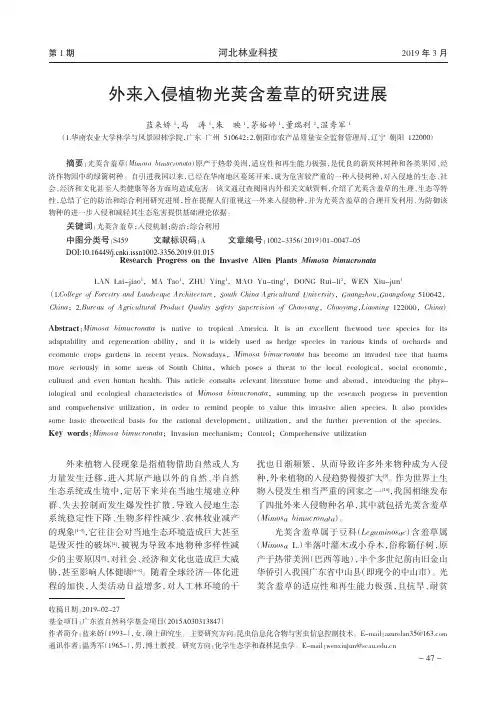
外来植物入侵现象是指植物借助自然或人为力量发生迁移,进入其原产地以外的自然、半自然生态系统或生境中,定居下来并在当地生境建立种群、失去控制而发生爆发性扩散,导致入侵地生态系统稳定性下降、生物多样性减少、农林牧业减产的现象[1-3],它往往会对当地生态环境造成巨大甚至是毁灭性的破坏[4],被视为导致本地物种多样性减少的主要原因[5],对社会、经济和文化也造成巨大威胁,甚至影响人体健康[6-8]。
随着全球经济一体化进程的加快,人类活动日益增多,对人工林环境的干扰也日渐频繁,从而导致许多外来物种成为入侵种,外来植物的入侵趋势慢慢扩大[9]。
作为世界上生物入侵发生相当严重的国家之一[10],我国相继发布了四批外来入侵物种名单,其中就包括光荚含羞草(Mimosa bimucronata )。
光荚含羞草属于豆科(Leguminosae )含羞草属(Mimosa L.)半落叶灌木或小乔木,俗称簕仔树,原产于热带美洲(巴西等地),半个多世纪前由旧金山华侨引入我国广东省中山县(即现今的中山市)。
光荚含羞草的适应性和再生能力极强,且抗旱、耐贫摘要:光荚含羞草(Mimosa bimucronata )原产于热带美洲,适应性和再生能力极强,是优良的薪炭林树种和各类果园、经济作物园中的绿篱树种。
自引进我国以来,已经在华南地区蔓延开来,成为危害较严重的一种入侵树种,对入侵地的生态、社会、经济和文化甚至人类健康等各方面均造成危害。
该文通过查阅国内外相关文献资料,介绍了光荚含羞草的生理、生态等特性,总结了它的防治和综合利用研究进展,旨在提醒人们重视这一外来入侵物种,并为光荚含羞草的合理开发利用、为防御该物种的进一步入侵和减轻其生态危害提供基础理论依据。
关键词:光荚含羞草;入侵机制;防治;综合利用中图分类号:S459文献标识码:A 文章编号:1002-3356(2019)01-0047-05Research Progress on the Invasive Alien Plants Mimosa bimucronataLAN Lai-jiao 1,MA Tao 1,ZHU Ying 1,MAO Yu-ting 1,DONG Rui-li 2,WEN Xiu-jun 1(1.College of Forestry and Landscape Architecture ,South China Agricultural University ,Guangzhou ,Guangdong 510642,China ;2.Bureau of Agricultural Product Quality Safety Supervision of Chaoyang ,Chaoyang ,Liaoning 122000,China )Abstract :Mimosa bimucronata is native to tropical America.It is an excellent firewood tree species for its adaptability and regeneration ability ,and it is widely used as hedge species in various kinds of orchards and ecomonic crops gardens in recent years.Nowadays ,Mimosa bimucronata has become an invaded tree that harms more seriously in some areas of South China ,which poses a threat to the local ecological ,social economic ,cultural and even human health.This article consults relevant literature home and abroad ,introducing the phys -iological and ecological characteristics of Mimosa bimucronata ,summing up the research progress in prevention and comprehensive utilization ,in order to remind people to value this invasive alien species.It also provides some basic theoretical basis for the rational development ,utilization ,and the further prevention of the species.Key words :Mimosa bimucronata ;Invasion mechanism ;Control ;Comprehensive utilization外来入侵植物光荚含羞草的研究进展蓝来娇1,马涛1,朱映1,茅裕婷1,董瑞利2,温秀军1(1.华南农业大学林学与风景园林学院,广东广州510642;2.朝阳市农产品质量安全监督管理局,辽宁朝阳122000)收稿日期:2019-02-27基金项目:广东省自然科学基金项目(2015A030313847)作者简介:蓝来娇(1993-),女,硕士研究生。
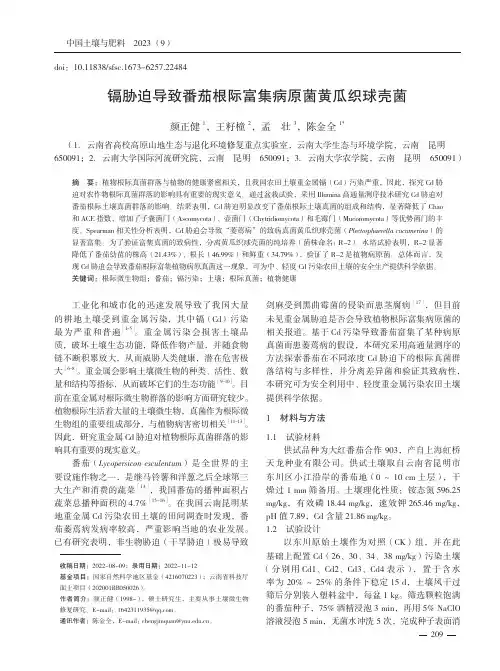
中国土壤与肥料 2023 (9)工业化和城市化的迅速发展导致了我国大量的耕地土壤受到重金属污染,其中镉(Cd)污染最为严重和普遍[1-5]。
重金属污染会损害土壤品质,破坏土壤生态功能,降低作物产量,并随食物链不断积累放大,从而威胁人类健康,潜在危害极 大[6-8]。
重金属会影响土壤微生物的种类、活性、数量和结构等指标,从而破坏它们的生态功能[9-10]。
目前在重金属对根际微生物群落的影响方面研究较少。
植物根际生活着大量的土壤微生物,真菌作为根际微生物组的重要组成部分,与植物病害密切相关[11-13]。
因此,研究重金属Cd胁迫对植物根际真菌群落的影响具有重要的现实意义。
番茄(Lycopersicon esculentum)是全世界的主要设施作物之一,是继马铃薯和洋葱之后全球第三大生产和消费的蔬菜[14],我国番茄的播种面积占蔬菜总播种面积的4.7%[15-16]。
在我国云南昆明某地重金属Cd污染农田土壤的田间调查时发现,番茄萎蔫病发病率较高,严重影响当地的农业发展。
已有研究表明,非生物胁迫(干旱胁迫)极易导致剑麻受到黑曲霉菌的侵染而患茎腐病[17],但目前未见重金属胁迫是否会导致植物根际富集病原菌的相关报道。
基于Cd污染导致番茄富集了某种病原真菌而患萎蔫病的假设,本研究采用高通量测序的方法探索番茄在不同浓度Cd胁迫下的根际真菌群落结构与多样性,并分离差异菌和验证其致病性,本研究可为安全利用中、轻度重金属污染农田土壤提供科学依据。
1 材料与方法1.1 试验材料供试品种为大红番茄合作 903,产自上海虹桥天龙种业有限公司。
供试土壤取自云南省昆明市东川区小江沿岸的番茄地(0~10 cm土层),干燥过 1 mm筛备用。
土壤理化性质:铵态氮596.25 mg/kg,有效磷18.44 mg/kg,速效钾265.46 mg/kg,pH值7.89,Cd含量21.86 mg/kg。
1.2 试验设计以东川原始土壤作为对照(CK)组,并在此基础上配置Cd(26、30、34、38 mg/kg)污染土壤(分别用Cd1、Cd2、Cd3、Cd4表示),置于含水率为 20%~25%的条件下稳定15 d,土壤风干过筛后分别装入塑料盆中,每盆1 kg。
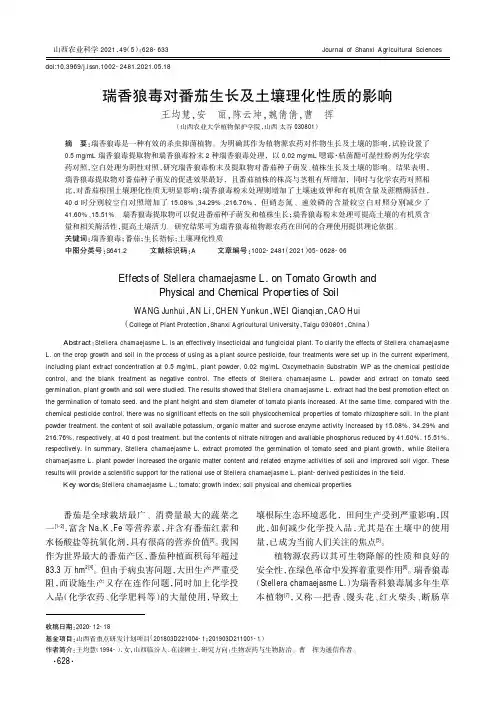
瑞香狼毒对番茄生长及土壤理化性质的影响王均慧,安丽,陈云坤,魏倩倩,曹挥(山西农业大学植物保护学院,山西太谷030801)摘要:瑞香狼毒是一种有效的杀虫抑菌植物。
为明确其作为植物源农药对作物生长及土壤的影响,试验设置了0.5mg/mL 瑞香狼毒提取物和瑞香狼毒粉末2种瑞香狼毒处理,以0.02mg/mL 噁霉·枯菌酯可湿性粉剂为化学农药对照,空白处理为阴性对照,研究瑞香狼毒粉末及提取物对番茄种子萌发、植株生长及土壤的影响。
结果表明,瑞香狼毒提取物对番茄种子萌发的促进效果最好,且番茄植株的株高与茎粗有所增加,同时与化学农药对照相比,对番茄根围土壤理化性质无明显影响;瑞香狼毒粉末处理则增加了土壤速效钾和有机质含量及蔗糖酶活性,40d 时分别较空白对照增加了15.08%、34.29%、216.76%,但硝态氮、速效磷的含量较空白对照分别减少了41.60%、15.51%。
瑞香狼毒提取物可以促进番茄种子萌发和植株生长;瑞香狼毒粉末处理可提高土壤的有机质含量和相关酶活性,提高土壤活力。
研究结果可为瑞香狼毒植物源农药在田间的合理使用提供理论依据。
关键词:瑞香狼毒;番茄;生长指标;土壤理化性质中图分类号:S641.2文献标识码:A文章编号:1002-2481(2021)05-0628-06Effects of Stellera chamaejasme L.on Tomato Growth andPhysical and Chemical Properties of SoilWANG Junhui ,AN Li ,CHEN Yunkun ,WEI Qianqian ,CAO Hui (College of Plant Protection ,Shanxi Agricultural University ,Taigu 030801,China )Abstract :Stellera chamaejasme L.is an effectively insecticidal and fungicidal plant.To clarify the effects of Stellera chamaejasme L.on the crop growth and soil in the process of using as a plant source pesticide,four treatments were set up in the current experiment,including plant extract concentration at 0.5mg/mL,plant powder,0.02mg/mL Oxcymethacin Substrabin WP as the chemical pesticide control,and the blank treatment as negative control.The effects of Stellera chamaejasme L.powder and extract on tomato seed germination,plant growth and soil were studied.The results showed that Stellera chamaejasme L.extract had the best promotion effect on the germination of tomato seed,and the plant height and stem diameter of tomato plants increased.At the same time,compared with the chemical pesticide control,there was no significant effects on the soil physicochemical properties of tomato rhizosphere soil.In the plant powder treatment,the content of soil available potassium,organic matter and sucrose enzyme activity increased by 15.08%,34.29%and 216.76%,respectively,at 40d post treatment,but the contents of nitrate nitrogen and available phosphorus reduced by 41.60%,15.51%,respectively.In summary,Stellera chamaejasme L.extract promoted the germination of tomato seed and plant growth ,while Stellera chamaejasme L.plant powder increased the organic matter content and related enzyme activities of soil and improved soil vigor.These results will provide a scientific support for the rational use of Stellera chamaejasme L.plant-derived pesticides in the field.Key words :Stellera chamaejasme L.;tomato;growth index;soil physical and chemical properties收稿日期:2020-12-18基金项目:山西省重点研发计划项目(201803D221004-1;201903D211001-1)作者简介:王均慧(1994-),女,山西临汾人,在读硕士,研究方向:生物农药与生物防治。
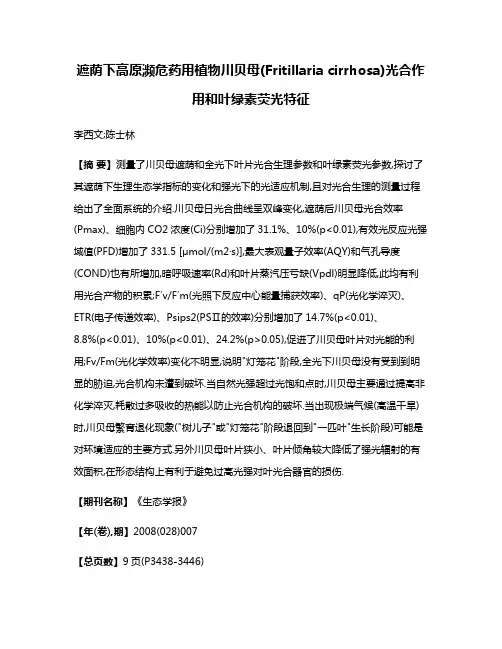
遮荫下高原濒危药用植物川贝母(Fritillaria cirrhosa)光合作用和叶绿素荧光特征李西文;陈士林【摘要】测量了川贝母遮荫和全光下叶片光合生理参数和叶绿素荧光参数,探讨了其遮荫下生理生态学指标的变化和强光下的光适应机制,且对光合生理的测量过程给出了全面系统的介绍.川贝母日光合曲线呈双峰变化,遮荫后川贝母光合效率(Pmax)、细胞内CO2浓度(Ci)分别增加了31.1%、10%(p<0.01),有效光反应光强域值(PFD)增加了331.5 [μmol/(m2·s)],最大表观量子效率(AQY)和气孔导度(COND)也有所增加,暗呼吸速率(Rd)和叶片蒸汽压亏缺(Vpdl)明显降低,此均有利用光合产物的积累;F′v/F′m(光照下反应中心能量捕获效率)、qP(光化学淬灭)、ETR(电子传递效率)、Psips2(PSⅡ的效率)分别增加了14.7%(p<0.01)、8.8%(p<0.01)、10%(p<0.01)、24.2%(p>0.05),促进了川贝母叶片对光能的利用;Fv/Fm(光化学效率)变化不明显,说明"灯笼花"阶段,全光下川贝母没有受到到明显的胁迫,光合机构未遭到破坏.当自然光强超过光饱和点时,川贝母主要通过提高非化学淬灭,耗散过多吸收的热能以防止光合机构的破坏.当出现极端气候(高温干旱)时,川贝母繁育退化现象("树儿子"或"灯笼花"阶段退回到"一匹叶"生长阶段)可能是对环境适应的主要方式.另外川贝母叶片狭小、叶片倾角较大降低了强光辐射的有效面积,在形态结构上有利于避免过高光强对叶光合器官的损伤.【期刊名称】《生态学报》【年(卷),期】2008(028)007【总页数】9页(P3438-3446)【关键词】川贝母(Fritillaria;cirrhosa);遮荫;光适应;叶绿素荧光;热耗散【作者】李西文;陈士林【作者单位】中国医学科学院,中国协和医科大学,药用植物研究所,北京100094;中国医学科学院,中国协和医科大学,药用植物研究所,北京100094【正文语种】中文【中图分类】Q948川贝母(Fritillaria cirrhosa D.Don)为百合科贝母属植物,已处于濒危状态。
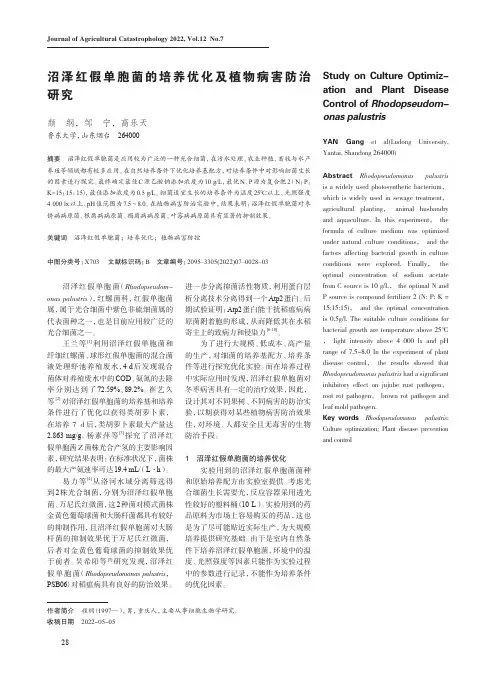
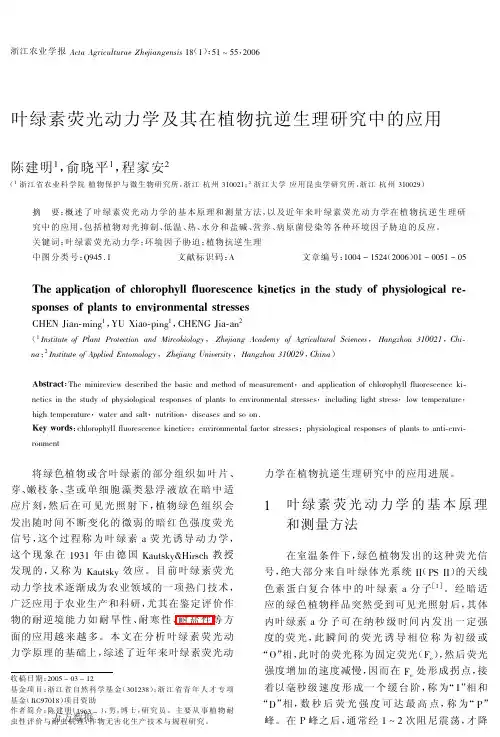
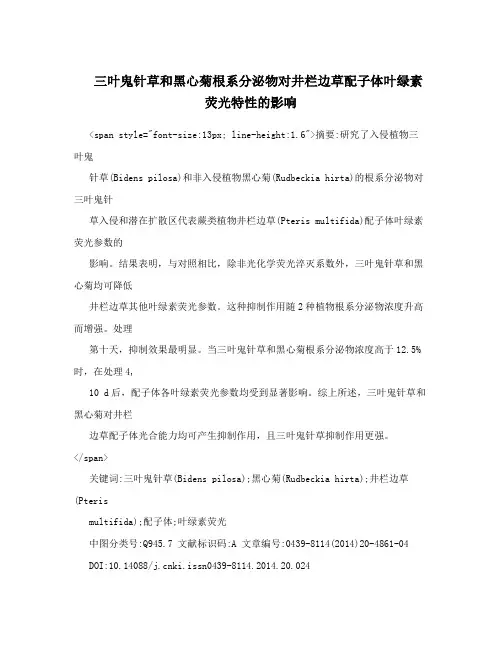
三叶鬼针草和黑心菊根系分泌物对井栏边草配子体叶绿素荧光特性的影响<span style="font-size:13px; line-height:1.6">摘要:研究了入侵植物三叶鬼针草(Bidens pilosa)和非入侵植物黑心菊(Rudbeckia hirta)的根系分泌物对三叶鬼针草入侵和潜在扩散区代表蕨类植物井栏边草(Pteris multifida)配子体叶绿素荧光参数的影响。
结果表明,与对照相比,除非光化学荧光淬灭系数外,三叶鬼针草和黑心菊均可降低井栏边草其他叶绿素荧光参数。
这种抑制作用随2种植物根系分泌物浓度升高而增强。
处理第十天,抑制效果最明显。
当三叶鬼针草和黑心菊根系分泌物浓度高于12.5%时,在处理4,10 d后,配子体各叶绿素荧光参数均受到显著影响。
综上所述,三叶鬼针草和黑心菊对井栏边草配子体光合能力均可产生抑制作用,且三叶鬼针草抑制作用更强。
</span>关键词:三叶鬼针草(Bidens pilosa);黑心菊(Rudbeckia hirta);井栏边草(Pterismultifida);配子体;叶绿素荧光中图分类号:Q945.7 文献标识码:A 文章编号:0439-8114(2014)20-4861-04 DOI:10.14088/ki.issn0439-8114.2014.20.024Effects of the Root Exudates of Bidens pilosa and Rudbeckia hirta on Chlorophyll Fluorescence of the Gametophyte of Pteris multifida ZHAND Kai-mei,SHEN Yu,LIU Ying,LIU Jun-hua,FANG Yan-ming(College of Forest Resources and Environment, Nanjing Forestry University,Nanjing 210037, China)Abstract: Pteris multifida is a common fern in China, with overlappingdistribution area with a main invasive plant Bidens pilosa in China. Root exudates of B. pilosa, as well as non invasive plant Rudbeckia hirta, were applied toinvestigate their effects on fluorescence in P. multifida gametophytes. We found that gametophytes exposed to both B. pilosa and R. hirta had decreased fluorescence parameters in comparison with the control, except for non photochemical quenching(NPQ). The inhibitory effects increased with increasing exudate concentrations of both species. The greatest inhibition exhibited at Day 10. Furthermore, it was foundthat these parameters were markedly affected from Day 4 to Day 10 in the presence of both exudates at a concentration of 12.5% or above. Itis concluded that both B. pilosa and R. hirta negatively affected the photosynthetic activity of P. multifida. Comparative research ofinvasive and non-invasive plants in our experiments demonstrated thatinvasive plants Bidens pilosa were responsible for the critical damage to local species.Key words: Pteris multifida; Rudbeckia hirta; Bidens Pilosa; Gametophyte; Chlorophyll fluorescence蕨类植物配子体为单倍体,结构简单,独立于孢子体生活,用于研究植物对环境的响应以及揭示其机理都具有独特的优势。
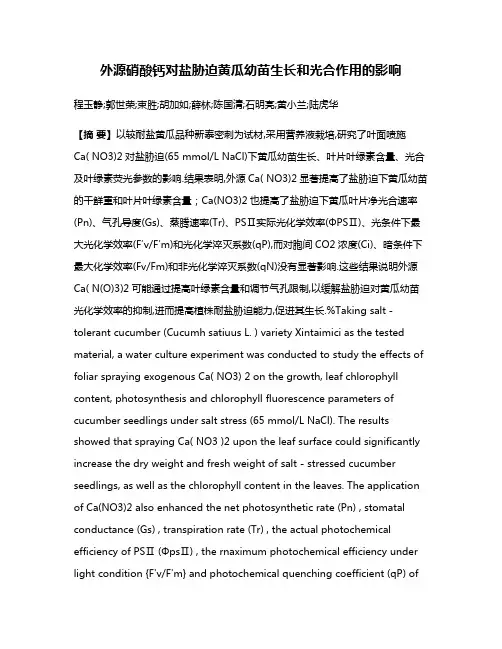
外源硝酸钙对盐胁迫黄瓜幼苗生长和光合作用的影响程玉静;郭世荣;束胜;胡加如;薛林;陈国清;石明亮;黄小兰;陆虎华【摘要】以较耐盐黄瓜品种新泰密刺为试材,采用营养液栽培,研究了叶面喷施Ca( NO3)2对盐胁迫(65 mmol/L NaCl)下黄瓜幼苗生长、叶片叶绿素含量、光合及叶绿素荧光参数的影响.结果表明,外源Ca( NO3)2显著提高了盐胁迫下黄瓜幼苗的干鲜重和叶片叶绿素含量;Ca(NO3)2也提高了盐胁迫下黄瓜叶片净光合速率(Pn)、气孔导度(Gs)、蒸腾速率(Tr)、PSⅡ实际光化学效率(ΦPSⅡ)、光条件下最大光化学效率(F′v/F′m)和光化学淬灭系数(qP),而对胞间CO2浓度(Ci)、暗条件下最大化学效率(Fv/Fm)和非光化学淬灭系数(qN)没有显著影响.这些结果说明外源Ca( N(O)3)2可能通过提高叶绿素含量和调节气孔限制,以缓解盐胁迫对黄瓜幼苗光化学效率的抑制,进而提高植株耐盐胁迫能力,促进其生长.%Taking salt - tolerant cucumber (Cucumh satiuus L. ) variety Xintaimici as the tested material, a water culture experiment was conducted to study the effects of foliar spraying exogenous Ca( NO3) 2 on the growth, leaf chlorophyll content, photosynthesis and chlorophyll fluorescence parameters of cucumber seedlings under salt stress (65 mmol/L NaCl). The results showed that spraying Ca( NO3 )2 upon the leaf surface could significantly increase the dry weight and fresh weight of salt - stressed cucumber seedlings, as well as the chlorophyll content in the leaves. The application of Ca(NO3)2 also enhanced the net photosynthetic rate (Pn) , stomatal conductance (Gs) , transpiration rate (Tr) , the actual photochemical efficiency of PSⅡ (ΦpsⅡ) , the rnaximum ph otochemical efficiency under light condition {F'v/F'm} and photochemical quenching coefficient (qP) ofcucumber seedling leaves under salt stress, but it had no significant influence on intercellular CO2 concentration (Ci) , maximal photochemical efficiency under dark condition (Fv/Frn) and non -photochemical quenching coefficient (qN). It was suggested that exogenous Ca(NO3)2 might alleviate the inhibition of salt stress to the photochemical efficiency, of cucumber seedlings, thus enhance their tolerance to salt stress, and promote their growth , through increasing the leaf chlorophyll content and regulating the limit of stoma.【期刊名称】《江西农业学报》【年(卷),期】2012(024)004【总页数】5页(P38-41,45)【关键词】硝酸钙;黄瓜;盐胁迫;光合荧光【作者】程玉静;郭世荣;束胜;胡加如;薛林;陈国清;石明亮;黄小兰;陆虎华【作者单位】南京农业大学园艺学院、农业部南方蔬菜遗传改良重点开放实验室,江苏南京 210095;江苏沿江地区农业科学研究所,江苏如皋 226541;南京农业大学园艺学院、农业部南方蔬菜遗传改良重点开放实验室,江苏南京 210095;南京农业大学园艺学院、农业部南方蔬菜遗传改良重点开放实验室,江苏南京 210095;江苏沿江地区农业科学研究所,江苏如皋 226541;江苏沿江地区农业科学研究所,江苏如皋 226541;江苏沿江地区农业科学研究所,江苏如皋 226541;江苏沿江地区农业科学研究所,江苏如皋 226541;江苏沿江地区农业科学研究所,江苏如皋 226541;江苏沿江地区农业科学研究所,江苏如皋 226541【正文语种】中文【中图分类】Q945盐胁迫已成为限制作物产量最重要的非生物因子之一[1]。
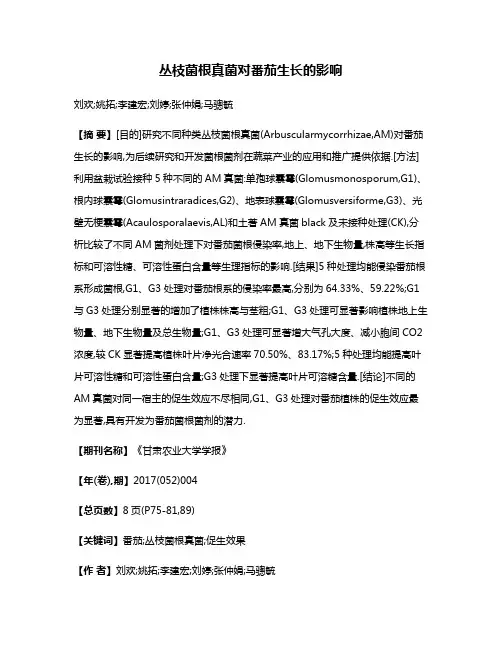
丛枝菌根真菌对番茄生长的影响刘欢;姚拓;李建宏;刘婷;张仲娟;马骢毓【摘要】[目的]研究不同种类丛枝菌根真菌(Arbuscularmycorrhizae,AM)对番茄生长的影响,为后续研究和开发菌根菌剂在蔬菜产业的应用和推广提供依据.[方法]利用盆栽试验接种5种不同的AM真菌:单孢球囊霉(Glomusmonosporum,G1)、根内球囊霉(Glomusintraradices,G2)、地表球囊霉(Glomusversiforme,G3)、光壁无梗囊霉(Acaulosporalaevis,AL)和土著AM真菌black及未接种处理(CK),分析比较了不同AM菌剂处理下对番茄菌根侵染率,地上、地下生物量,株高等生长指标和可溶性糖、可溶性蛋白含量等生理指标的影响.[结果]5种处理均能侵染番茄根系形成菌根,G1、G3处理对番茄根系的侵染率最高,分别为64.33%、59.22%;G1与G3处理分别显著的增加了植株株高与茎粗;G1、G3处理可显著影响植株地上生物量、地下生物量及总生物量;G1、G3处理可显著增大气孔大度、减小胞间CO2浓度,较CK显著提高植株叶片净光合速率70.50%、83.17%;5种处理均能提高叶片可溶性糖和可溶性蛋白含量;G3处理下显著提高叶片可溶糖含量.[结论]不同的AM真菌对同一宿主的促生效应不尽相同,G1、G3处理对番茄植株的促生效应最为显著,具有开发为番茄菌根菌剂的潜力.【期刊名称】《甘肃农业大学学报》【年(卷),期】2017(052)004【总页数】8页(P75-81,89)【关键词】番茄;丛枝菌根真菌;促生效果【作者】刘欢;姚拓;李建宏;刘婷;张仲娟;马骢毓【作者单位】甘肃农业大学草业学院,草业生态系统教育部重点实验室,甘肃省草业工程实验室,中-美草地畜牧业可持续发展研究中心,甘肃兰州 730070;甘肃农业大学草业学院,草业生态系统教育部重点实验室,甘肃省草业工程实验室,中-美草地畜牧业可持续发展研究中心,甘肃兰州 730070;甘肃农业大学草业学院,草业生态系统教育部重点实验室,甘肃省草业工程实验室,中-美草地畜牧业可持续发展研究中心,甘肃兰州 730070;甘肃农业大学草业学院,草业生态系统教育部重点实验室,甘肃省草业工程实验室,中-美草地畜牧业可持续发展研究中心,甘肃兰州 730070;甘肃农业大学草业学院,草业生态系统教育部重点实验室,甘肃省草业工程实验室,中-美草地畜牧业可持续发展研究中心,甘肃兰州 730070;甘肃农业大学草业学院,草业生态系统教育部重点实验室,甘肃省草业工程实验室,中-美草地畜牧业可持续发展研究中心,甘肃兰州 730070【正文语种】中文【中图分类】S641.2番茄(Lycopersicon esculentum)又名西红柿或洋柿子,植物分类学上属茄科(Solanaceae)番茄属(Lycopersicon),是世界上重要蔬菜之一,其果实富含维生素和矿质元素,尤其以番茄红素和胡萝卜素而闻名.有研究表明,番茄还具有降低肺癌、直肠癌等多种癌症发病率的功效.近年来,番茄越来越受人们的青睐,其种植面积也逐年扩大,全国总种植面积接近20万hm2.根据世界加工番茄理事会的数据,我国已经成为世界第二大番茄种植国和番茄酱生产国.因而,番茄不仅对于提高人民饮食营养的具有很高的利用价值,还对农民增收和农村发展具有重要的意义[1].但是,番茄的生长过程对氮磷钾等矿质元素的依赖程度非常高,传统种植中,主要依靠施用大量化肥来获取较高产量,这不仅增加了农民的购买性投入,推高生产成本,而且化肥的大量使用还会造成土壤退化、生态失衡等一系列严重问题,不仅如此,化肥的大量使用还影响了食品安全.因此,这一问题已成为限制番茄产业发展的瓶颈问题之一.寻找一种安全、绿色、环保的新型技术就是一项极为迫切的工作,而近些年来发展的丛枝菌根真菌接种技术为这一问题的解决带来了新的思路. 菌根(Mycorrhizae)是自然界中普遍存在的一种共生现象,是高等植物根系与土壤中一类特定真菌形成的互惠共生体,其中以丛枝菌根在自然界的分布最为广泛[2].丛枝菌根真菌(Arbuscular mycorrhizae,AM)是分布广泛的土居微生物,能够与地球上大部分植物形成共生体[3],其通过根外菌丝为宿主植物供给营养物质,不仅可以促进植物对土壤中P[4]、N[5]、Cu[6]、Fe[7]等营养元素和水分[8]的吸收,提高植物的产量和品质[9],增强植物耐受盐碱胁迫[10]、干旱胁迫[11]、重金属污染[12]和病虫害[13、14]等各种逆境胁迫的能力,而且作为多功能的高效生物肥料还具有改良土壤结构,减少化肥、农药的施用,恢复受损生态系统,对环境保护、园林绿化以及农业的可持续发展具有深远的意义[15].鉴于此,本研究选择了5种AM真菌菌剂,研究其对番茄生长的影响,进而探究AM真菌与番茄生长的相互作用机理,以期利用AM真菌提高番茄产量和改善品质,为我国番茄产业的发展提供新思路,同时为菌根技术在蔬菜产业的应用和推广提供理论依据.1.1 宿主植物番茄(Lycopersicum esclulentum)为甘肃省农业科学院蔬菜所提供的‘浙杂809号’.1.2 菌种供试菌株皆由甘肃农业大学草业学院草地生物多样性实验室提供.分别为:单孢球囊霉(Glomus monosporum,简称G1);根内球囊霉(Glomus intraradices,简称G2);地表球囊霉(Glomus versiforme,简称G3);光壁无梗囊霉(Acaulospora laevis,简称AL);土著AM真菌(未鉴定,简称black).5种AM真菌在接种之前,皆采用玉米为宿主植物进行扩繁,接种物中包括AM真菌孢子、根外菌丝及被侵染宿主植物根段的沙土混合物.1.3 试验地条件盆栽试验在甘肃农业大学温室进行,试验期间温室温度为(25±4)℃,光照时间为14~15 h.供试土壤采于甘肃省农科院蔬菜所试验地,土壤pH 7.51,全氮89 mg/kg,速效氮8.2 mg/kg,全磷392.6 mg/kg,速效磷7.21 mg/kg.采集土壤过2 mm网筛后,在1×105 Pa下湿热灭菌2 h.采用规格为16 cm×20 cm×12 cm的塑料花盆作为培养容器,装土之前,用70%乙醇对花盆进行消毒.1.4 试验设计以番茄为宿主植物,设置5个接种处理和1个未接种对照(CK),每个处理重复3次.挑选饱满、均一的宿主植物种子,采用次氯酸钠溶液(有效氯成份≤10%)消毒,然后用蒸馏水多次冲洗,转移至内含滤纸的培养皿中,放置于培养箱中发芽后,移栽至花盆,每盆栽种4株.播种时,每个花盆装灭菌基质2.5 kg,然后将15 g接种剂(1 g菌剂约含60个孢子)平铺其上,再覆盖0.5 kg灭菌基质.未接种处理每盆施用15 g灭菌接种物和15 mL无灭菌接种物水滤液,以保证微生物区系的一致性.花盆随机摆放,种植期间每隔1 d浇水1次,以保证番茄的正常生长.1.5 样品收获及分析测定1.5.1 AMF菌根侵染率的测定采用曲利苯兰染色法测定[16],于种植后第60天,收获番茄植株.根系用自来水洗净,然后置于10% KOH溶液中,85 ℃水浴加热40 min.清水冲洗后置于1%HCl中酸化,1~2 min后将根系放置于曲利苯蓝染色液中,85 ℃水浴染色40 min,取出后用自来水反复冲洗,将染色根切成长度为1 cm左右的根段,在解剖镜下观察,利用交叉网格线法测定菌根侵染率.1.5.2 番茄植株株高、茎粗的测量分别于试验第30 d和60 d时对番茄植株的株高和茎粗进行测量.1.5.3 番茄叶片光合作用的测定利用光合仪Li-6400测定植株叶片气孔导度、胞间CO2浓度和净光合速率,取样部位为植株从上往下数第3片叶片.1.5.4 番茄叶片可溶性糖含量的测定采用蒽酮法测定[17],摘取植株上从上往下数第3片叶片,烘干后粉碎,称取0.500 g于试管中,加入15 mL蒸馏水,沸水浴20 min,冷却后,过滤在50 mL容量瓶中,用蒸馏水冲洗残渣数次,最后定容至刻度线待用.吸取1 mL待测液,加入5 mL蒽酮试剂,沸水浴10 min,冷却后进行比色.1.5.5 番茄叶片可溶性蛋白含量的测定采用考马斯亮蓝G-250法进行测定[18],摘取植株上从上往下数第2片叶片,称取1.0 g,加入少量石英砂进行研磨,研磨成浆之后定容至100 mL容量瓶中,静置30 min后过滤.吸取1 mL滤液和5 mL 考马斯亮蓝G-250试剂于试管中,摇匀之后于595 nm下进行比色.1.6 数据分析试验数据采用SPSS(v17.0)软件计算±s.所有测定数据的平均值采用LSD法在显著水平为5%条件下进行比较,当P<0.05时,差异显著.采用Excel 2003软件制图.2.1 AMF菌根侵染率5种AMF中,处理G1、G3对根系侵染率分别为(64.33±1.59)%、(59.22±1.92)%,显著高于black(48.62±1.40)%、G2(45.47±1.22)%,处理AL 侵染率最低,仅为(23.37%±1.45)%(图1).由于CK中加入灭菌后的接种物,因此其侵染率为0.该结果表明不同AMF真菌处理对宿主植物的菌根侵染率不相同,即不同AMF对番茄根系的侵染能力不同.2.2 AMF对番茄生长指标的影响2.2.1 AMF对番茄株高、茎粗的影响接种初期(30 d),处理间差异不显著(P>0.05),但均与CK有显著差异(P<0.05).接种60 d时,G1处理下番茄株高最高(21.39±1.38) cm,与CK相比提高42.01%,其余各处理较CK均有提高.番茄植物茎粗的变化与株高变化趋势基本相似.该结果表明,供试5种AMF均可不同程度的促进番茄植株的生长,其中G1、G3菌剂效果最佳(图2-3).2.2.2 AMF对番茄地下、地上及总生物量的影响研究表明,5种AMF均可显著增加番茄植株地下生物量(P<0.05),处理G1、G3表现最佳,分别为(0.87±0.18)、(0.84±0.12)g;处理AL促进效应最弱,但与处理CK相比增幅仍到达44.08%(图4-A).研究发现,5种AMF皆可显著促进番茄地上生物量的增长(P<0.05).5种处理中,G1、G3促进效果最明显,分别为(5.46±0.12)、(5.49±0.08)g,但二者之间无显著性差异(P>0.05).处理G2、AL表现相对较弱,但与处理CK相比仍具有显著性差异(P<0.05,图4-B).与处理CK相比较,5种AMF均可显著促进番茄植株的总生物量.但不同AMF处理对番茄的促进效果不尽相同,处理G1、G3表现最佳,但二者之间无显著差异(P>0.05).处理G2、AL表现较弱,仍比处理CK增加38.77%、28.82%(图4-C).菌根效应是反映植物生长对AM真菌需要程度的指标.试验表明,接种不同AM真菌菌剂后,番茄总生物量对菌根的依赖程度不尽相同.对番茄接种5种AM真菌后(图4-D),植株对菌剂G1、G3的依赖性显著大于其他菌剂处理,其中对菌剂G1、G3的依赖性分别为54.50%、54.49%,而对菌剂AL的依赖性最弱为22.34%.这也说明在番茄的生长中,处理G1、G3对植株具有较高的促进作用,而处理AL促进作用不明显.2.3 AMF对番茄叶片光合作用的影响与对照相比,5种AM真菌菌剂均能提高植物叶片的净光合速率(图5-A),其中以black、G1、G3的效果最为显著(P<0.05),与对照可分别提高64.14%、70.50%、83.17%;接种AM真菌后也显著的提高了植株叶片的气孔导度(图5-B),其中以菌剂G3最为明显.番茄叶片气孔导度的大小为:G3>G1>black>G2>AL>CK,这与番茄叶片光合速率的变化相一致.而番茄叶片胞间CO2浓度的关系为G3<G1<black<G2<AL<CK,与光合速率和气孔导度的变化相反,除菌剂G1与AL外,其余各处理间无显著性差异(P>0.05),但均与CK有显著性差异(P<0.05).其中一些菌剂与对照相比,虽未有显著变化,但均不同程度的增加了叶片光合速率、气孔导度,从而提高了植株的光合特性.2.4 AMF对番茄叶片生理特性的影响2.4.1 AMF对番茄叶片可溶性糖的影响各接菌处理均与CK有显著差异(P<0.05),处理G1与处理G2、G3、AL差异显著(P<0.05).由图5可知,不同AMF处理对番茄叶片可溶性糖含量的提高程度不尽相同,G1、G3两个处理对番茄叶片可溶性糖含量的促进效果最为显著,与对照相比分别提高了157.6%、157.8%;接种AL 后作用较不明显,与CK相比仅增加45.74%(图6).2.4.2 AMF对番茄叶片可溶性蛋白含量的影响各处理对番茄叶片可溶性蛋白含量的影响见图7,与对照相比,处理black、G1、G2、G3、AL对番茄叶片可溶性蛋白含量均有不同程度的增加,其中处理G1、G3作用最为明显,与CK相比差异显著;处理black、G2表现较好,与CK相比分别增加了16.19%、9.35%;处理AL表现较差,促进作用最弱.3.1 AMF菌根侵染率的影响菌根侵染率是评价AM真菌与植物建立共生关系与否的重要指标,也是讨论菌根对植物抗逆性影响的前提[19].一般认为当菌根侵染率越高,植物菌根化程度也会相应越高,对植物促进作用、抗逆性能力的增加也会越明显.本试验中,所选用的五种丛枝菌根真菌均能有效侵染番茄,而前人采用同种真菌在水稻[20]、菊花[21]、白三叶草[22]、番茄[23]等植物上试验,也得到了相似的结果,说明这些真菌具有较广的宿主适应性.此外,试验还发现,不同AM菌剂的侵染率亦有明显差异.这表明宿主植物对不同AM真菌的响应不同,同时AM真菌对宿主植物存在选择性.Johnson等[24]认为:不同种类的植物可直接或间接的通过自身根系环境,对群落中不同的AM真菌进行选择.另外,前人在葡萄、猕猴桃、黄瓜、牡丹等植物上也已经验证了这一理论.由此可见,AM真菌的侵染率是受宿主植物和AM真菌本身特性双重因素调控的,即在AM真菌的应用过程中,要注意宿主植物和所选用菌株的匹配性.3.2 AMF对番茄生长发育的影响生物量是衡量植株生长状况的重要指标之一.试验中,接种不同种AM真菌后,番茄生长量均有不同程度增加,这可能是由于AM真菌侵染植物根系之后,通过根外菌丝的介入,扩大了植物根系的吸收范围,增强了植物对水分和营养元素的吸收.而较为充足的营养元素和水分的供应又促进了作物地上部分的生长,从而对番茄植株的生长起到了良好促进作用.张瑞[25]对紫花苜蓿进行了接种AM真菌处理,得到了相似的结果.试验还发现,接种不同菌剂导致番茄植株生物量之间存在明显差异.推测其可能的原因一是不同的AM真菌对营养元素和水分的吸收能力不同;二是与该种AM真菌和番茄的匹配性有关.王茜等[26]的研究也得到了相似的结果. 3.3 AMF对番茄生理特性叶片光合作用的影响AM真菌是一类异养型的真菌,其生存需从寄主体内吸收碳源,根内菌丝主要从根系中吸收可溶性糖,从而在根系建立“菌根碳库”[27-28].本研究表明,接种AM 真菌后显著提高了番茄叶片内可溶性糖和可溶性蛋白的含量,其中处理G1、G3作用最为显著.接种AM真菌后,植株组织内更高的可溶性糖含量为AM的发育提供了碳源.此外试验还发现,接种AM菌剂后可有效的提高番茄叶片中的气孔导度和净光合速率,而胞间CO2浓度明显降低.而气孔导度的增大,使得外界环境中更多CO2进入了叶肉细胞中,为叶片光合作用提供的足量原料;同时促进了CO2同化利用效率,降低胞间CO2浓度,进一步提高光合效率,促进番茄植株生长,因而改善植物的光合参数,提高植株叶片光合速率,间接地使植物获得更多的碳水化合物[29-31].这一结果暗示可溶性糖将有利于AM的形成和发育,此外,植物根系的生长和发育也对可溶性糖有较高的依赖性[32].可溶性糖如葡糖糖能直接作为生长调节物质或糖代谢反应的底物影响植物细胞的分裂,从而促进植物的生长发育[33].因此,在接种AM真菌时应注意提供较充足的可溶性糖.通过对不同丛枝菌根真菌接种番茄后的生长指标进行研究得出以下结论:研究所采用的5种AM真菌均能促进番茄株高、茎粗、地上生物量、地下生物量、总生物量、光合作用、可溶性糖含量和可溶性蛋白含量,且不同菌株促进能力不同,其中单孢球囊霉和地表球囊霉促进作用较为明显,具有开发应用潜力;而内球囊霉、光壁无梗囊霉、土著AM真菌的促进作用相对不明显.【相关文献】[1] 林兴军.不同水肥对日光温室番茄品质和抗氧化系统及土壤环境的影响[D].北京:中国科学院研究生院,2011.[2] 李媛媛,王晓娟,豆存艳,等.四种宿主植物及其不同栽培密度对AM真菌扩繁的影响[J].草业学报,2013,22(5):128-135.[3] SIMTH S E,READ D J.Mycorrhizal Symbiosis[M].3rd edn.New York:Academic Press,2008.[4] BAIRD J,WALLEY F L,SHIRTLIFFE S J.Arbuscular mtcorrhizal fungi colonization and phosphorus nutrition in organic filed pea and lentil[J].Mycorrhiza,2010,20:541-549. [5] ATUL-NAYYAR A,HAMEL C,HANSON K,et al.The arbuscular mycorrhizal symbiosis links N mineralization to plant demand[J].Mycorrhiza,2009,19:239-246.[6] LIU A,HAMEL C,HAMILTON R I,et al.Acquisition of Cu,Zn,Mn and Fe by mycorrhizal maize (Zea mays L.) grown in soil at different P and micronutrientleves[J].Mycorrhiza,2000,9:331-336.[7] CARIS C,HÖRDT W,HAWKINS H J,et al.Studies of iron transport by arbuscularmycorrhizal hyphae from soil peanut and sorghum plants[J].Mycorrhiza,1998,8:35-39. [8] NEUMANN E,SCHMID B,RÖMHELD V,et al.Extraradical development and contribution to plant performance of an arbuscular mycorrhizal symbiosis exposed to complete or partial rootzone drying[J].Mycorrhiza,2009,20:21-23.[9] TOUSSAINT J P,SMITH F A,SMITH S E.Arbuscular mycorrhizal fungi can induce the production of phytochemicals in sweet basil irrespective of phosphorusnutrition[J].Mycorrhiza,2007,17:291-297.[10] GARCA I V,MENDOZA R E.Arbuscular mycorrhizal fungi and plant symbiosis in a saline-sodic soil[J].Mycorrhiza,2007,17:167-174.[11] MENA-VIOLANTE H G,OCAMPO-JIMÉNEZ O,DENDOOVEN L,et al.Arbuscular myorrhizal fungi enhance fruit growth and quality of chile ancho (Capsicum annuum L.cv San Luis) plants exposed to drought[J].Mycorrhiza,2006,16:261-267.[12] YU Y,ZHANG S Z,HUANG H L.Behavior of mercury in a soil-plant syesten as affected by inoculuation with the arbuscular mycorrhizal fungus Glomusmosseae[J].Mycorrhiza,2010,20:407-414.[13] KAMISKA M,KLAMKOWSKI K,BERMIAK H,et al.Response of mycorrhizal periwinkle plants to aster yellows phytoplasma infection[J].Mycorrhiza,2010,20:161-166.[14] Elsen A,Gervacio D,Swennen R,et al.AMF-induced biocontrol against plant parasitic nematodes in Musa sp.:a systemic effect[J].Mycorrhiza,2008,18:251-256.[15] GIANINAZZI S,GOOLOTTE A,BINET M N,et al.Agroecology:the key role of arbusculaar mycorrhizas in ecosystem services[J].Mycorrhiza,2010,20:519-530.[16] KOSKE R E,GEMMA J N.A modified procedure for staining roots to detect VA mycorrhizas[J].Mycological Research,1989,92(4):486-488.[17] 成广雷,张海娇,赵久然,等.临界胁迫贮藏条件下不同基因型玉米种子活力及生理变化[J].中国农业科学,2015,48(1):33-42.[18] 邓丽莉,潘晓倩,生吉萍,等.考马斯亮蓝法测定苹果组织微量可溶性蛋白含量的条件优化[J].食品科学,2012,33(24):185-189.[19] 任爱天,鲁为华,杨洁晶,等.不同磷水平下AM真菌对紫花苜蓿生长和磷利用的影响[J].中国草地学报,2014,36(6):72-78.[20] 马放,李哲,王立,等.丛枝菌根真菌对农药三环唑的残留减量研究[J].哈尔滨工业大学学报,2013,45(4):58-63.[21] SINGH KANWAR P,KUMAR K R,PRASAD K V,et al.Influence of VAM inoculation on root colonization,survival,physiological and biochemical characteristics of chrysanthemum plantlets[J].Indian Joural of Horticulture,2008,65(4):974-985.[22] 王立,徐亚男,马放,等.不同AMF菌剂对白三叶草坪的扶壮作用[J].哈尔滨工业大学学报,2012,44(10):43-47.[23] 龙良鲲,黎志坤,姚青,等.番茄菌根化育苗及对青枯病的防治试验[J].中国蔬菜,2009(4):52-55.[24] JOHNSON N C,GRAHAM J H,SMITH F A.Functioning of mycorrhzizal associations along the mutualism-parasitism continuum[J].New Phytologist,1997,135:575-585.[25] 张瑞.盐碱土壤接种菌根对紫花苜蓿的综合效应[D].呼和浩特:内蒙古农业大学,2009.[26] 王茜,王强,王晓娟,等.不同丛枝菌根真菌对青藏高原高寒草原优良牧草垂穗披碱草生长的促生效应[J].云南农业大学学报,2014,29(6):840-846.[27] BAGO B,PFEFFER P E,Shachar-Hill Y.Carbon metabolism and transport in arbuscular mycorrhizas[J].Plant Physiology,2000,124:949-958.[28] BAGO B,PFEFFER P E,ABUBAKER J,et al.Carbon export from arbuscular mycorrhizal roots involves the translocation of carbohydrate as well as lipid[J].PlantPhysiology,2003,131:1496-1507.[29] 吉春龙,田萌萌,马继芳,等.丛枝菌根真菌对植物营养代谢与生长影响的研究进展[J].浙江师范大学学报(自然科学版),2010,33(3):303-309.[30] 杨睿,郁继华,吕剑,等.不同肥料对基质栽培樱桃番茄生长和产量的影响[J].甘肃农业大学学报,2016,51(1):69-76.[31] 谢鹏虓,黄鹏,安丹军.配施生物有机肥及化肥减量对玉米间作豌豆土壤微生物及产量的影响[J].甘肃农业大学学报,2014,49(6):41-46.[32] KIRCHER S,SCHOPFER P.Photosynthetic sucrose acts as cotyledon-derived long-distance signal to control growth during early seedlings development inArabidopsis[J].Proceeding of the National Academy of Sciences,2012,109:11217-11221.[33] FRANCIS D.The cell cycle in plant development[J].New Phytologist,1992,122:1-20.。
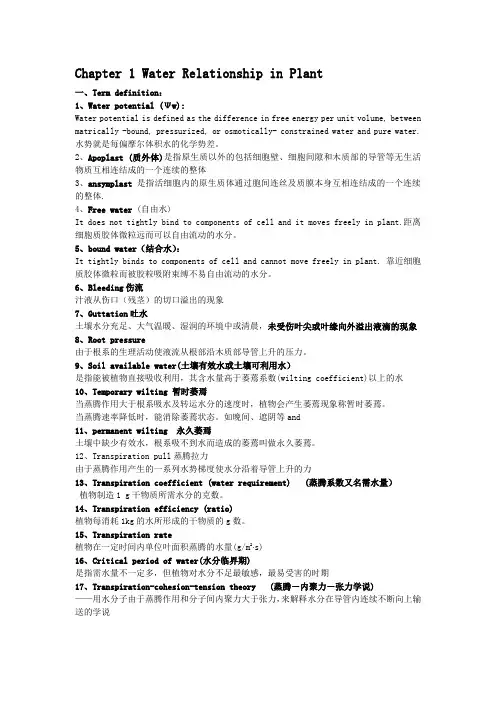
Chapter 1 Water Relationship in Plant一、Term definition:1、Water potential (Ψw):Water potential is defined as the difference in free energy per unit volume, between matrically -bound, pressurized, or osmotically- constrained water and pure water.水势就是每偏摩尔体积水的化学势差。
2、Apoplast (质外体)是指原生质以外的包括细胞壁、细胞间隙和木质部的导管等无生活物质互相连结成的一个连续的整体3、ansymplast是指活细胞内的原生质体通过胞间连丝及质膜本身互相连结成的一个连续的整体.4、Free water (自由水)It does not tightly bind to components of cell and it moves freely in plant.距离细胞质胶体微粒远而可以自由流动的水分。
5、bound water(结合水):It tightly binds to components of cell and cannot move freely in plant. 靠近细胞质胶体微粒而被胶粒吸附束缚不易自由流动的水分。
6、Bleeding伤流汁液从伤口(残茎)的切口溢出的现象7、Guttation吐水土壤水分充足、大气温暖、湿润的环境中或清晨,未受伤叶尖或叶缘向外溢出液滴的现象8、Root pressure由于根系的生理活动使液流从根部沿木质部导管上升的压力。
9、Soil available water(土壤有效水或土壤可利用水)是指能被植物直接吸收利用,其含水量高于萎蔫系数(wilting coefficient)以上的水10、Temporary wilting 暂时萎焉当蒸腾作用大于根系吸水及转运水分的速度时,植物会产生萎蔫现象称暂时萎蔫。
REVIEWFungicideimpactsonphotosynthesisincropplantsAnne-Noe¨llePetit•FlorenceFontaine•
ParulVatsa•ChristopheCle´ment•
NathalieVaillant-Gaveau
Received:27March2011/Accepted:12January2012/Publishedonline:1February2012ÓSpringerScience+BusinessMediaB.V.2012
AbstractFungicidesarewidelyusedtocontrolpestsincropplants.However,ithasbeenreportedthatthesepes-ticidesmayhavenegativeeffectsoncropphysiology,especiallyonphotosynthesis.Analterationinphotosyn-thesismightleadtoareductioninphotoassimilatepro-duction,resultinginadecreaseinbothgrowthandyieldofcropplants.Forexample,acontactfungicidesuchascopperinhibitsphotosynthesisbydestroyingchloroplasts,affectingphotosystemIIactivityandchlorophyllbiosyn-thesis.Systemicfungicidessuchasbenzimidazoles,ani-lides,andpyrimidinearealsophytotoxic,whereasazolesstimulatephotosynthesis.Thisarticlefocusesontheavailableinformationabouttoxiceffectsoffungicidesonphotosynthesisincropplants,highlightingthemechanismsofperturbation,interaction,andthetargetsitesofdifferentclassesoffungicides.
KeywordsChlorophyllÁCropplantsÁFungicidesÁPhotosynthesisÁPhotosystemsÁPhysiologyÁPhytotoxicityÁStomatalclosureÁStress
IntroductionFungicidesremainavitalsolutiontotheeffectivecontrolofplantdiseases,whichareestimatedtocauseyieldreductionsofalmost20percentinmajorfoodandcash
cropsworldwide.Thegreatvarietyofknownfungicidescanbeclassifiedintotwomaincategories:contactandsystemic.Contactfungicides,suchascopperorsulfurhaveapreventiveactionbykillingfungiastheirsporesgermi-nate,beforemyceliacangrowanddevelopwithinplanttissues(YusteandGostincar1999).Sincetheirintroduc-tioninthe1960’s,systemicfungicideshavegraduallyreplacedoldernon-systemicproducts,establishinghigherlevelsofdiseasecontrolanddevelopingnewfungicidemarkets.Systemicfungicides,knownascurativeoreradi-cationfungicides,canalsokillthefunguswhenmyceliahavepenetratedintotheparenchyma,stoppingthedis-persalorinfectionwithintheplant(Table1,YusteandGostincar1999).Amongsystemicfungicides,benzimi-dazolesareagroupoforganicfungicidesthatareexten-sivelyusedinagriculturealongwiththeotherclassesoffungicides.Allthesetypesofcompoundscontrolabroadrangeoffungiatrelativelylowapplicationrates.However,theeffectsoffungicidesoncropgrowthdependonvariousfactors.Applicationoffungicidesmayaffectcropphysi-ologybyvariousdisruptionssuchasgrowthreduction,perturbationinthedevelopmentofreproductiveorgans,alterationofnitrogen,and/orcarbonmetabolismleadingtoalowernutrientavailabilityforplantgrowth.Thesensi-tivityofsomeplantspeciesmaydependonthedevelop-mentalstage(i.e.moresensitivetothetreatmentsatyoungstagesorduringcriticaleventssuchasreproduction)orthetypeofpesticidesused.Ithasbeenpreviouslyreportedthatinresponsetoastress,plantsoftenmobilizenutrientsandmetabolitepro-ductiontodevelopdefensemechanismsindetrimenttogrowth(SmithandMoser1985).Understressconditions,plantsfirstlytriggertheirdefenceresponsefortheirsur-vivalbecauseoftheenergeticcostofresistanceand
A.-N.PetitÁF.FontaineÁP.VatsaÁC.Cle´mentÁN.Vaillant-Gaveau(&)LaboratoiredeStress,De´fensesetReproductiondesPlantes,URVVCEA2069,Universite´deReimsChampagne-Ardenne,UFRSciencesExactesetNaturelles,Baˆtiment18,MoulindelaHousse,BP1039,51687ReimsCedex2,Francee-mail:nathalie.vaillant-gaveau@univ-reims.fr
123
PhotosynthRes(2012)111:315–326DOI10.1007/s11120-012-9719-8Table1Basicchemicalcharacteristicsoffungicides(datafromInternationalUnionofPureAppliedChemistry)Fungicides,FormulesStructuresPrimarymodeofactioninfungus
Copperand/orsulfateBordeauxmixtureCuSO4Á3Cu(OH)23CaSO4Inhibitseveralenzymesinvolvedinrespirationandthismulti-siteaction(Leroux2003)
KumulusSxInhibitseveralenzymesinvolvedinrespirationandthismulti-siteaction(Leroux2003)
Cuproxat3Cu(OH)2CuSO4
Inhibitseveralenzymesinvolvedinrespirationandthismulti-siteaction(Leroux2003)
StrobilurineKresoxim-methylC18H19NO4Inhibitssporegerminationandmycelialgrowth(Lerouxetal.2002)QoIinhibitors,whichacttoinhibittherespiratorychainatthelevelofComplexIII(Grossmannetal.1999)
AzoxystrobinC22H17N3O5Inhibitssporegerminationandmycelialgrowth(Zhangetal.2010)
PyrroleFludioxonilC12H6F2N2O2
Perturbetheosmo-regulatorysignaltransmissionpathway(PillonelandMeyer1997)
Inhibitssporegerminationandmycelialgrowth(Lerouxetal.2002)
AnilidesFenhexamidC19H15FN2O4
Inhibitsgerm-tubeelongationandmycelialgrowth(Ha¨nblerandPontzen1999)
Asterolbiosynthesisinhibitor:inhibitsthe3-ketoreductaseinvolvedintheenzymaticcomplexofthesterolC-4demethylation(Debieuetal.2001)
PhthalimideFolpetC9H4Cl3NO2SInhibitssporegerminationandmycelialgrowthMulti-siteaction(Teisseireetal.1999)